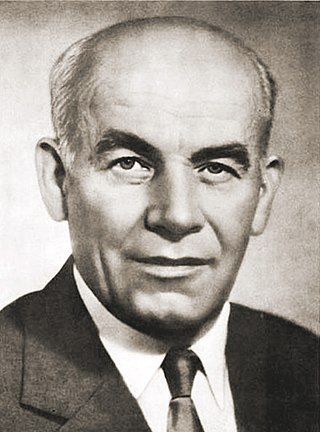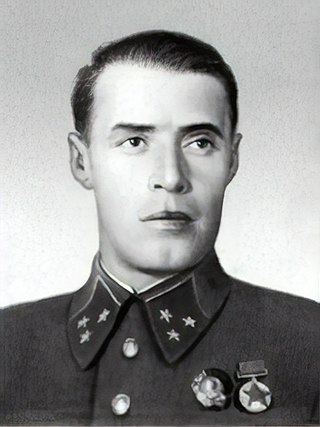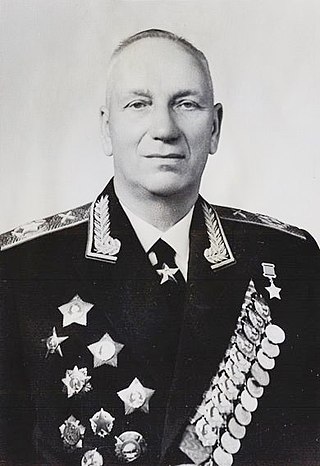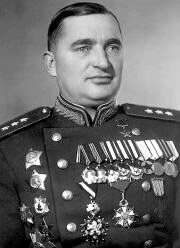This article needs additional citations for verification .(October 2021) |
| |||||
| Decades: | |||||
|---|---|---|---|---|---|
| See also: | |||||
The following lists events that happened during 1943 in the Union of Soviet Socialist Republics .
This article needs additional citations for verification .(October 2021) |
| |||||
| Decades: | |||||
|---|---|---|---|---|---|
| See also: | |||||
The following lists events that happened during 1943 in the Union of Soviet Socialist Republics .

Kliment Yefremovich Voroshilov, popularly known as Klim Voroshilov, was a prominent Soviet military officer and politician during the Stalin-era. He was one of the original five Marshals of the Soviet Union, the second highest military rank of the Soviet Union, and served as Chairman of the Presidium of the Supreme Soviet, the nominal Soviet head of state, from 1953 to 1960.

Georgy Konstantinovich Zhukov was a Marshal of the Soviet Union. He also served as Chief of the General Staff, Minister of Defence, and was a member of the Presidium of the Communist Party. During World War II, Zhukov oversaw some of the Red Army's most decisive victories, after which he was appointed the military governor of the Soviet Occupation Zone in Germany.

Władysław Gomułka was a Polish Communist politician. He was the de facto leader of post-war Poland from 1947 until 1948, and again from 1956 to 1970.

The Polish Workers' Party was a communist party in Poland from 1942 to 1948. It was founded as a reconstitution of the Communist Party of Poland (KPP) and merged with the Polish Socialist Party (PPS) in 1948 to form the Polish United Workers' Party (PZPR). From the end of World War II the PPR led Poland, with the Soviet Union exercising moderate influence. During the PPR years, the centers of opposition activity were largely diminished, and a socialist system was established in the country.

The Eastern Front was a theatre of World War II fought between the European Axis powers and Allies, including the Soviet Union (USSR) and Poland. It encompassed Central Europe, Eastern Europe, Northeast Europe (Baltics), and Southeast Europe (Balkans), and lasted from 22 June 1941 to 9 May 1945. Of the estimated 70–85 million deaths attributed to World War II, around 30 million occurred on the Eastern Front, including 9 million children. The Eastern Front was decisive in determining the outcome in the European theatre of operations in World War II, eventually serving as the main reason for the defeat of Nazi Germany and the Axis nations. It is noted by historian Geoffrey Roberts that "More than 80 per cent of all combat during the Second World War took place on the Eastern Front".

Semyon Mikhailovich Budyonny was a Soviet cavalryman, military commander during the Russian Civil War, Polish-Soviet War and World War II, and politician, who was a close political ally of Soviet leader Joseph Stalin.

Aleksandr Mikhaylovich Vasilevsky was a Soviet career-officer in the Red Army who attained the rank of Marshal of the Soviet Union in 1943. He served as the Chief of the General Staff of the Soviet Armed Forces (1942–1945) and Deputy Minister of Defense during World War II, and as Minister of Defense from 1949 to 1953. As the Chief of the General Staff from 1942 to 1945, Vasilevsky became involved in planning and coordinating almost all the decisive Soviet offensives in World War II, from the Operation Uranus of November 1942 to the assaults on East Prussia, Königsberg and Manchuria.

Ivan Stepanovich Konev was a Soviet general and Marshal of the Soviet Union who led Red Army forces on the Eastern Front during World War II, responsible for taking much of Axis-occupied Eastern Europe.

Konstantin Konstantinovich Rokossovsky was a Soviet and Polish officer who became a Marshal of the Soviet Union, a Marshal of Poland, and served as Poland's Defence Minister from 1949 until his removal in 1956 during the Polish October. He became one of the most prominent Red Army commanders of World War II.

Markian Mikhaylovich Popov was a Soviet military commander, Army General, and Hero of the Soviet Union (1965).

Joseph Edward Davies was an American lawyer and diplomat. He was appointed by President Wilson to be Commissioner of Corporations in 1912, and he was the first chairman of the Federal Trade Commission in 1915. He was the second ambassador to represent the United States in the Soviet Union and U.S. Ambassador to Belgium and Luxembourg. From 1939 to 1941 Davies was special assistant to Secretary of State Hull, in charge of War Emergency Problems and Policies. From 1942 through 1946 he was chairman of President Roosevelt's War Relief Control Board. Ambassador Davies was special advisor of President Harry Truman and Secretary of State James F. Byrnes with rank of ambassador at the Potsdam Conference in 1945.

The Third Moscow Conference between the major Allies of World War II took place during October 18 to November 11, 1943, at the Moscow Kremlin and Spiridonovka Palace. It was composed of major diplomats, ministers and generals, who discussed cooperation in the war effort, and issued the Moscow Declaration.

Nikolay Nikolayevich Voronov was a Soviet military leader, chief marshal of the artillery (1944), and Hero of the Soviet Union. He was commander of artillery forces of the Red Army from 1941 until 1950. Voronov commanded the Soviet artillery during the Battle of Stalingrad and was the Stavka representative to various fronts during the Siege of Leningrad and the Battle of Kursk. He also fought in the Russian Civil War, the Polish-Soviet War and the Battle of Khalkin Gol, as well as serving as an advisor to the Spanish Republican Army during the Spanish Civil War.

Generalissimus of the Soviet Union was the highest military rank in the Soviet Union, created after World War II for Joseph Stalin and awarded to him on 27 June 1945. Stalin soon came to regret the rank, which he considered too ostentatious, and continued to wear his Marshal insignia and uniform.

Georgy Maximilianovich Malenkov was a Soviet politician who briefly succeeded Joseph Stalin as the leader of the Soviet Union. However, at the insistence of the rest of the Presidium, he relinquished control over the party apparatus in exchange for remaining Premier and first among equals within the Soviet collective leadership. He then became embroiled in a power struggle with Nikita Khrushchev that culminated in his removal from the premiership in 1955 as well as the Presidium in 1957.

Nikolai Alexandrovich Bulganin was the Premier of the Soviet Union from 1955 to 1958. He also served as Minister of Defense, following service in the Red Army during World War II.

Lev Borisovich Kamenev was a Russian revolutionary and Soviet politician. He was born in Moscow to parents who had both been involved in revolutionary politics in the 1870s. He joined the Russian Social Democratic Labour Party (RSDLP) in 1901 and was active in Moscow and Saint Petersburg. Kamenev participated in the failed Russian Revolution of 1905. Relocating abroad in 1908, he became an early member of the Bolsheviks and a close associate of the exiled Vladimir Lenin. In 1914, he was arrested upon returning to Saint Petersburg and exiled to Siberia. Kamenev was able to return after the February Revolution of 1917, which overthrew the Tsarist monarchy. In 1917, he served briefly as the equivalent of the first head of state of Soviet Russia. He disagreed with Lenin's strategy of armed uprising during the October Revolution but nevertheless remained in a position of power after the fall of the Provisional Government. In 1919, Kamenev was elected a full member of the first Politburo.
The following lists events that happened during 1945 in the Union of Soviet Socialist Republics.
The following lists events that happened during 1949 in the Union of Soviet Socialist Republics.

Aleksey Semenovich Zhadov, born with the surname "Zhidov", was a Soviet military officer in the Red Army, who during World War II commanded the 66th Army, later renamed the 5th Guards Army, from the Battle of Stalingrad up till the end of the war. For his leadership of the army, Zhadov was awarded the title Hero of the Soviet Union. Postwar, Zhadov commanded the Central Group of Forces and was deputy commander of the Soviet Ground Forces.